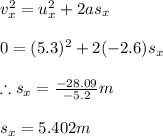

Answers: 2


Other questions on the subject: Physics

Physics, 21.06.2019 16:00, aprilkenedy12
Your pendulum clock which advances 1.0 s for every complete oscillation of the pendulum is running perfectly on earth at a site where the magnitude of the acceleration due to gravity is 9.80 m/s2. you send the clock to a location on the moon where the magnitude of the acceleration due to gravity is 1.65 m/s2.
Answers: 2

Physics, 22.06.2019 14:30, val926
When is a current produced? when the terminals of an electrochemical cell are connected by a wire if the electric circuit is opened in an electrochemical cell if the electrolyte is removed from an electrochemical cell when the electrodes are reversed in an electrochemical cell
Answers: 2

Physics, 22.06.2019 19:30, CalCDanG
Assume that two of the electrons at the negative terminal have attached themselves to a nearby neutral atom. there is now a negative ion with a charge -2e at this terminal. what are the electric potential and electric potential energy of the negative ion relative to the electron? the electric potential and the electric potential energy are both twice as much. the electric potential is twice as much and the electric potential energy is the same. the electric potential is the same and the electric potential energy is twice as much. the electric potential and the electric potential energy are both the same. the electric potential is the same and the electric potential energy is increased by the mass ratio of the oxygen ion to the electron. the electric potential is twice as much and the electric potential energy is increased by the mass ratio of the oxygen ion to the electron.
Answers: 3

Physics, 22.06.2019 20:40, mathman783
Abasketball star covers 2.65 m horizontally in a jump to dunk the ball. his motion through space can be modeled precisely as that of a particle at his center of mass. his center of mass is at elevation 1.02 m when he leaves the floor. it reaches a maximum height of 1.90 m above the floor and is at elevation 0.910 m when he touches down again. (a) determine his time of flight (his "hang time"). (b) determine his horizontal velocity at the instant of takeoff. (c) determine his vertical velocity at the instant of takeoff. (d) determine his takeoff angle. (e) for comparison, determine the hang time of a whitetail deer making a jump with center-of-mass elevations yi = 1.20 m, ymax = 2.45 m, and yf = 0.750 m.
Answers: 1
You know the right answer?
Aparticle starts from the origin at t = 0 with an initial velocity of 5.3 m/s along the positive x a...
Questions in other subjects:



Chemistry, 10.03.2020 18:45







Chemistry, 10.03.2020 18:46













